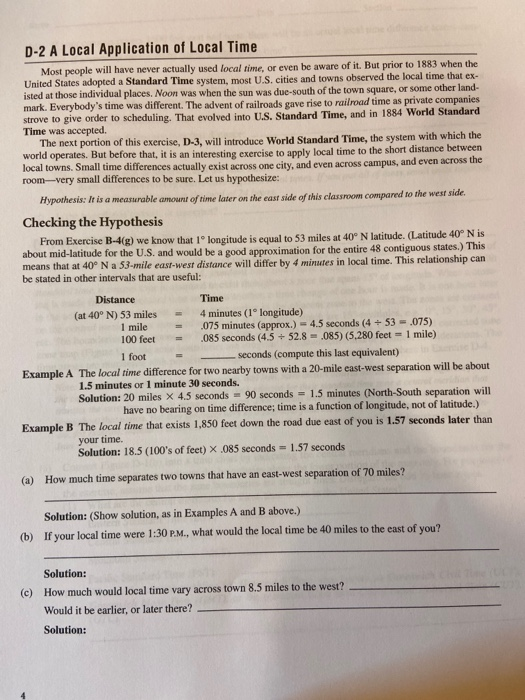Answered step by step
Verified Expert Solution
Question
1 Approved Answer
D-2 A Local Application of Local Time Most people will have never actually used local time, or even be aware of it. But prior


D-2 A Local Application of Local Time Most people will have never actually used local time, or even be aware of it. But prior to 1883 when the United States adopted a Standard Time system, most U.S. cities and towns observed the local time that ex- isted at those individual places. Noon was when the sun was due-south of the town square, or some other land- mark. Everybody's time was different. The advent of railroads gave rise to railroad time as private companies strove to give order to scheduling. That evolved into U.S. Standard Time, and in 1884 World Standard Time was accepted. The next portion of this exercise, D-3, will introduce World Standard Time, the system with which the world operates. But before that, it is an interesting exercise to apply local time to the short distance between local towns. Small time differences actually exist across one city, and even across campus, and even across the room-very small differences to be sure. Let us hypothesize: Hypothesis: It is a measurable amount of time later on the east side of this classroom compared to the west side. Checking the Hypothesis From Exercise B-4(g) we know that 1 longitude is equal to 53 miles at 40 N latitude. (Latitude 40 N is about mid-latitude for the U.S. and would be a good approximation for the entire 48 contiguous states.) This means that at 40 N a 53-mile east-west distance will differ by 4 minutes in local time. This relationship can be stated in other intervals that are useful: Time 4 minutes (1 longitude) .075 minutes (approx.) = 4.5 seconds (4+53 = .075) .085 seconds (4.5+ 52.8= .085) (5,280 feet = 1 mile) seconds (compute this last equivalent) 1 foot Example A The local time difference for two nearby towns with a 20-mile east-west separation will be about 1.5 minutes or 1 minute 30 seconds. Solution: 20 miles X 4.5 seconds Distance (at 40 N) 53 miles 1 mile. 100 feet 90 seconds= 1.5 minutes (North-South separation will have no bearing on time difference; time is a function of longitude, not of latitude.) Example B The local time that exists 1,850 feet down the road due east of you is 1.57 seconds later than your time. Solution: 18.5 (100's of feet) x .085 seconds= 1.57 seconds (a) How much time separates two towns that have an east-west separation of 70 miles? Solution: (Show solution, as in Examples A and B above.) (b) If your local time were 1:30 P.M., what would the local time be 40 miles to the east of you? Solution: (c) How much would local time vary across town 8.5 miles to the west? Would it be earlier, or later there? Solution: Name Date Section (d) If your campus covers 1500 feet east and west, there will be an actual local time difference across cam- pus, if accurately measured by the sun. How much time? Solution:
Step by Step Solution
★★★★★
3.31 Rating (166 Votes )
There are 3 Steps involved in it
Step: 1
Question 1 Time separation solutions a How much time separates two towns se...
Get Instant Access to Expert-Tailored Solutions
See step-by-step solutions with expert insights and AI powered tools for academic success
Step: 2

Step: 3

Ace Your Homework with AI
Get the answers you need in no time with our AI-driven, step-by-step assistance
Get Started


